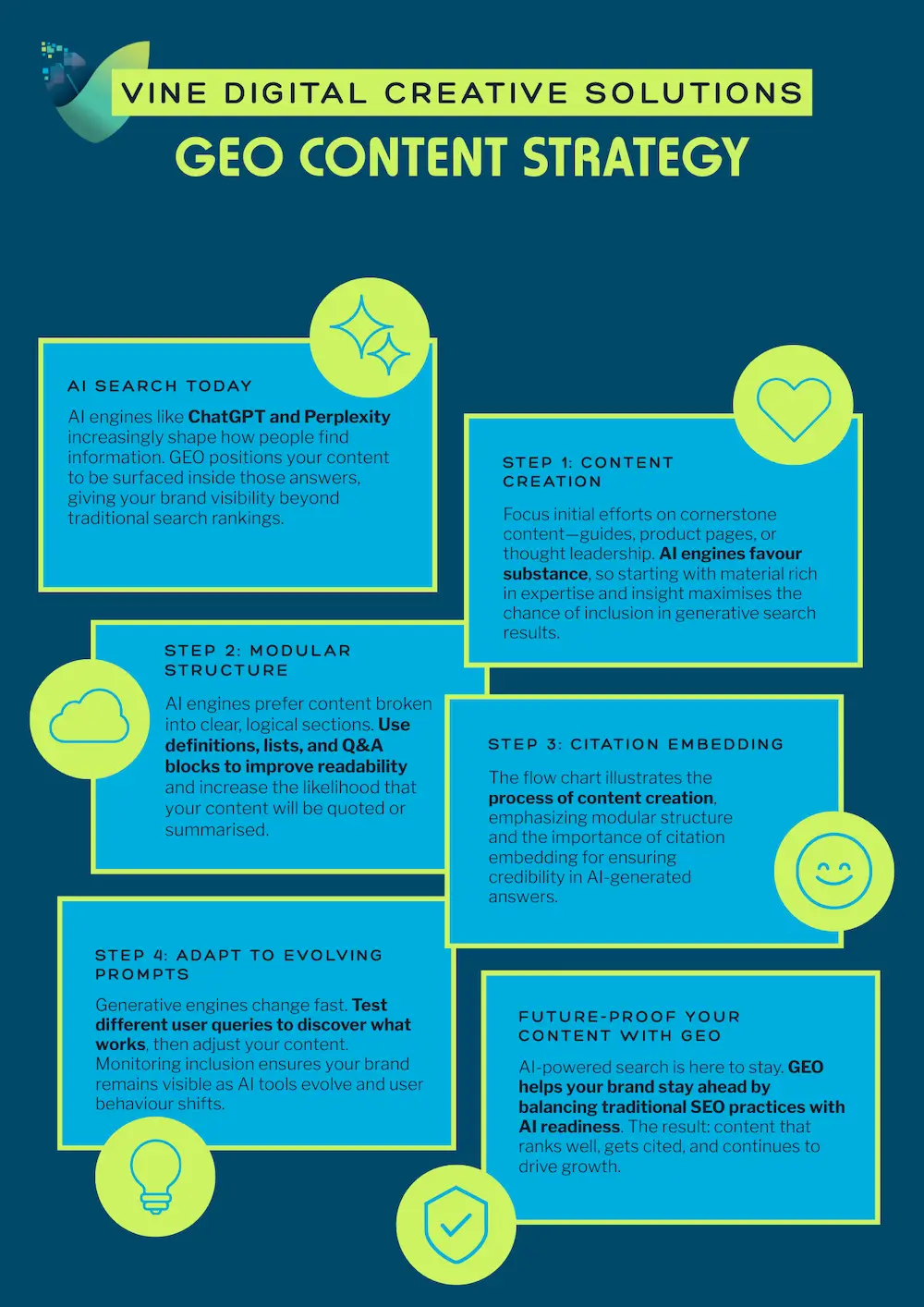Search is evolving
With AI-powered engines like ChatGPT, Google AI Overviews, and Perplexity becoming frontline discovery tools, simply ranking on page one of search results is no longer enough. Your content now needs to be selected — cited, excerpted, or embedded within AI-generated answers. This is the foundation of Generative Engine Optimisation (GEO).
What is GEO — and what’s new (Sept 2025)?
| Generative Engine Optimisation (GEO) is the practice of shaping and structuring content so it appears in the answers generated by AI engines, not just in the blue links of a search results page. |
This term was introduced in late 2023 through the paper Generative Engine Optimisation: How to Dominate AI Search (revised June 2024), which proposed a black-box optimisation framework for improving visibility in AI search. The framework introduced GEO-bench — a benchmark of 10,000 diverse queries across categories like Business, History, Science, and Opinion, designed to test how AI engines cite and embed content.
The study found that:
- AI engines prefer authoritative, cited content. Tactics like adding references, quotations, and statistics consistently improved visibility.
- Well-structured GEO adjustments can boost visibility by up to 40%.
- Lower-ranked websites benefit most. For instance, adding citations improved visibility by 115.1% for sites ranked fifth in search results, while reducing visibility for the top-ranked site by 30.3%.
- Domain-specific optimisations matter. Facts queries responded best to citations; Debate and History queries responded best to authoritative tone.
These results highlight that GEO is not about tricking algorithms, but about content clarity, credibility, and accessibility — the same fundamentals that have always underpinned good SEO.
How GEO has evolved in the past 2 years
In the past month, Google’s Danny Sullivan reiterated at WordCamp US (Aug 28, 2025) that:
“Good SEO is good GEO.”
Sullivan emphasised that the fundamentals remain unchanged: write useful, unique, clear content for people. What changes is where and how that content is surfaced — whether in blue links, voice answers, or AI-generated snippets.
He also noted that click-through rates are falling in some verticals as impressions rise, a phenomenon dubbed “the great decoupling of search”. While Google is unapologetic about zero-click factual answers, the company has said it remains committed to rewarding valuable content and supporting the open web.
Meanwhile, industry tools are emerging to support GEO. Wix recently launched an AI Visibility Overview that tracks how often content is cited in AI engines and benchmarks competitor presence — an early sign that GEO reporting will become a standard part of content marketing.
GEO vs SEO: How they work together
| Focus | SEO | GEO |
| Goal | Improve rankings, click-throughs, organic traffic | Get content cited or embedded in AI answers |
| Focus | Backlinks, domain authority, on-page optimisation | Authoritativeness, structured reasoning, citations, clarity |
| Metric | Rank position, impressions, clicks | Citation frequency, snippet presence, AI-answer placement |
SEO still matters. Research shows that pages ranked #1 in Google are picked up in AI search around 25% of the time. But GEO adds a new dimension: your content must now be AI-friendly as well as search-friendly.
Practical steps to begin GEO
1. Audit existing content for AI potential
Identify cornerstone content — guides, product or service pages, and thought leadership articles that already drive traffic. These are prime candidates for GEO testing, especially in categories where clarity and citations carry weight.
2. Modular structure & clear logic
AI engines prefer structured, easy-to-digest content. Use definitions, bullet lists, comparisons, and Q&A blocks to make information more extractable. This aligns with “fluency optimisation” and “easy-to-understand” tactics that showed significant uplift in the GEO study.
3. Embed references and authority
Strengthen trust signals by including citations, quotes, statistics, and third-party references. In the GEO research, citation embedding was one of the most effective methods, particularly in fact-based queries.
4. Engine-specific testing
Prompt ChatGPT, Bing Copilot, and Perplexity with niche queries and see which content appears. This practical approach helps identify gaps and opportunities for GEO refinements.
5. Monitor AI visibility
Use emerging tools like Wix’s AI Visibility Overview or set up your own query tracking to measure how often you appear in AI summaries and cited sources.
6. Iterate as queries evolve
User behaviour is shifting — queries are becoming more conversational. Update your content to reflect new phrasing, add fresh statistics, and refine reasoning structures to maintain inclusion.

Need help adapting your SEO strategy to AI search? Talk to Vine Digital about making your content AI-citable as well as Google-ranked.
Why GEO will endure
- AI discovery is growing: More people ask questions to AI engines than click traditional links.
- First-mover advantage: Early adopters create citation momentum in AI.
- Layered strategy: A solid GEO strategy extends and expands a solid SEO strategy.
- Core principles still apply: Evidence, clarity, and expertise matter more than ever.
As Danny Sullivan put it, “what you’ve been doing for SEO is still what you should be doing.” The difference is that GEO gives those same efforts visibility in AI search experiences.
Related Posts
Join the Newsletter
Want quick and digestible insights, delivered fortnightly to your inbox?
Our newsletter will keep you up to speed with the latest updates and opportunities in your industry.
